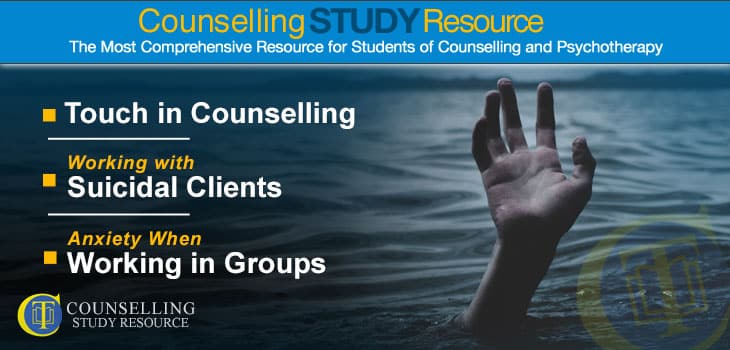086 – Touch in Counselling – Working with Suicidal Clients – Anxiety When Working in Groups
In episode 86 of the Counselling Tutor Podcast, Ken Kelly and Rory Lees-Oakes look at the difficult issue of touch in counselling. In ‘Practice Matters’, Rory describes strategies from his experience of working with suicidal clients. The presenters end the episode by talking about the anxiety that can naturally hit us when working in a group setting – and how we can help assuage this.
Touch in Counselling (starts at 1.53 mins)
Is it ethical to touch a client? Might doing so be comforting to the client? This is a very tricky issue, and one that is fraught with danger in the counselling context.
Rory notes that as far back as ten years ago, Brian Thorne and Dave Mearns – in an earlier edition of their book Person-Centred Counselling in Action (the latest edition of which was published in 2013 by Sage) – advised therapists (particularly male ones) not to touch clients. But can it be so wrong – for example – to put your hand on a client’s hand to show humanity when they are upset?
Ken and Rory provide the following tips:
- Always think first: if you feel the need to touch a client, who is the touch for? In other words, would you be doing it to comfort the client or in fact to comfort yourself somehow? If the latter, explore this in supervision.
- Consent is vital – so don’t initiate touch yourself, but if the client does so (e.g. seems to be asking for a hug), then be sure that it is OK with them to respond.
- If you do decide that touching a client is appropriate, document this in the notes.
- If you work with children, it’s best never to touch, as this can more easily be misinterpreted by young people. Many organisations that work with children have a policy of no touch.
Personal space is a very delicate topic, and Rory shares that if he wishes even to move his chair closer to a client, he will check: ‘Is this space comfortable for you?’ Ken notes that if touch feels a difficult area for you, you might wish to explore this in personal counselling.
Working with Suicidal Clients (starts at 10.06 mins)
The possibility of being faced with a suicidal client – and what you should do if this does happen – are common areas of concern for student counsellors as they start their placements. Rory offers some observations from his own practice and teaching on this topic:
- Find out the organisation’s policy for disclosure of suicidal ideation.
- Be clear on the threshold of disclosure, e.g. the mention of suicide at all or having a clear plan for suicide?
- Know who you would disclose to and the procedure (i.e. what goes on after you have disclosed – e.g. a staff member from the agency might speak to the client and then take them to A&E in a taxi if need be).
- Don’t panic: use the relationship to explore what the client wants, and to help them feel understood.
- Explore options for living, using ‘anchors’ (protective factors) such as children, partners and enjoyable activities.
- Have details of support groups and crisis lines to hand.
- Get the support that you need, remembering to look after yourself too: speak to your supervisor (and personal counsellor if the talk of suicide brings up difficult issues for you).
Rory has an interview in the Counselling Study Resource (CSR) with Eoin Galavan, a clinical and counselling psychologist in Ireland. Eoin suggests reminding clients that if they’re not there, therapy can’t take place. This can help give them hope for change.
Finally, Rory lists various myths and facts, courtesy of the Samaritans; the relevant links are provided in his handout, which can be downloaded here, and is also available in the Handouts Vault and CSR.
Anxiety When Working in Groups (starts at 22.22 mins)
Many learners feel nervous when working in a group, especially a new one. Counselling courses require particularly close group working, with both triads and PD (personal development) groups.
Again, Rory and Ken offer nuggets of advice on this:
- A good group contract is important – so that everyone knows the limits of confidentiality.
- Don’t feel forced to share: although made-up stories don’t work well in skills practice, you can draw on how you felt during a good or bad day rather than having to explore ‘heavy’ topics as you find your feet in the group.
- If you feel anxious in a group, use this to look into self: you might even choose to disclose these feelings in your PD group.
- Try to rotate so that you work with different people in the group, perhaps choosing to sit in a different place each week.
- Listen to others but find your own voice too.
- Try to ‘let go’ of your previous group (if you’ve studied another level of counselling before your current one), being open to making new alliances and leaving behind old ones that may have become less productive.
Good luck to all our listeners starting new courses this autumn!
Free Handout Download
Working with Suicidal Clients
